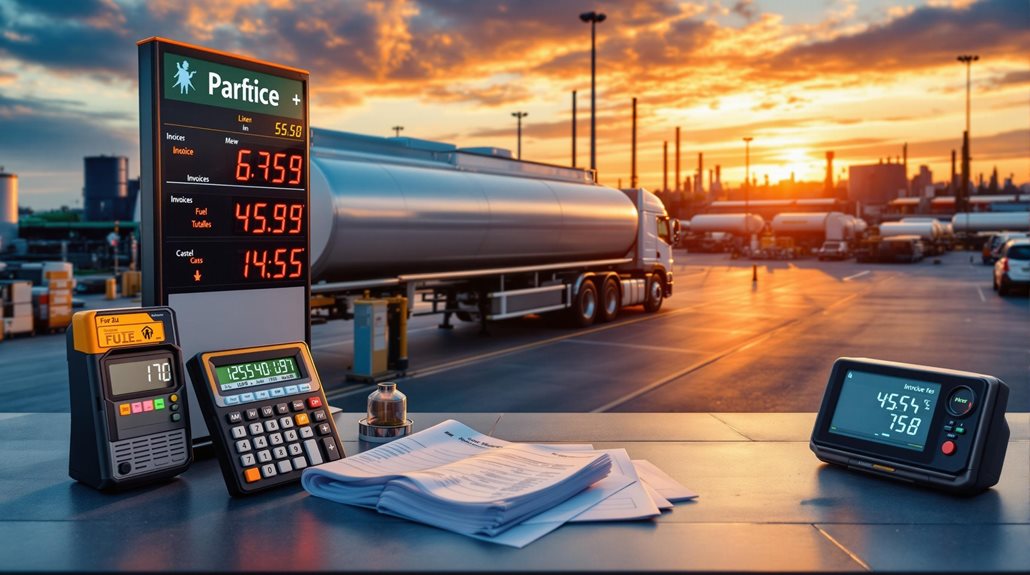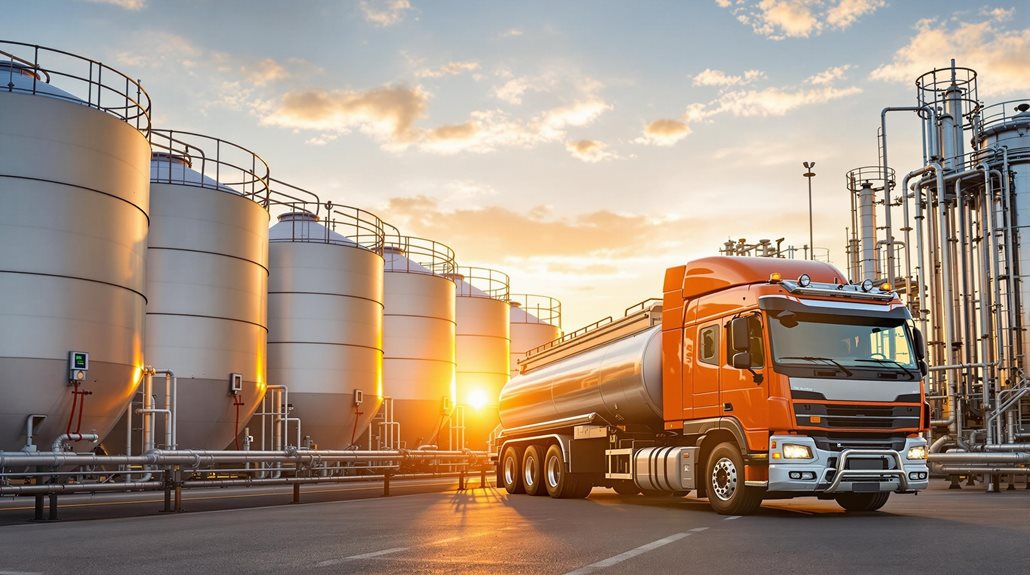Fuel delivery assistance costs typically include several components that affect the final price. Base service fees range widely depending on location and time of service, while distance-based charges add to the total cost through mileage rates. Emergency or after-hours service requests often incur premium charges, with fees potentially exceeding $646 for urgent situations. Many providers offer membership programs that can reduce or eliminate extra charges for emergency services. Variables such as delivery volume, special handling requirements, and geographic accessibility profoundly influence pricing structures. Understanding these cost factors enables businesses and individuals to make informed decisions about their fuel delivery needs.
Expert Highlights
- Base service fees typically include delivery charges, with additional costs for distance traveled and fuel quantity requested.
- Emergency fuel delivery during after-hours can cost over $646, with higher rates for remote or limited-access locations.
- Membership programs offer reduced rates and waived after-hours charges for regular customers needing fuel delivery assistance.
- Fuel surcharges fluctuate weekly based on national averages, affecting the final cost of delivery services.
- Geographic location and time of service request significantly impact pricing, with urban areas offering more competitive rates.
Understanding Fuel Delivery Pricing Models

Fuel delivery pricing models encompass a complex interplay of variables that determine the final cost of fuel transportation services. Companies typically structure their pricing through either flat-rate systems, which maintain consistent fees regardless of delivery specifics, or variable-rate models that adjust based on factors such as distance, quantity, and fuel type. Selecting local fuel suppliers can dramatically reduce transportation costs and improve delivery efficiency. The Towing service often includes specialized equipment and tools, which can influence overall operational costs.
Organizations can optimize their fuel expenses by understanding and leveraging these pricing structures effectively. Bulk purchase arrangements often provide substantial cost advantages, while contractual agreements offer price stability over extended periods. Active fuel management programs provide detailed reporting and back-office support to better control spending. The most advantageous pricing model depends on specific operational requirements, delivery frequency, and volume needs.
When evaluating options, businesses should consider both immediate costs and long-term financial implications while factoring in additional service charges such as labor costs and specialized handling requirements.
Emergency Service Cost Factors
Emergency fuel delivery costs are enormously influenced by the customer's geographic location and the time of service request, with urban areas typically commanding higher base rates due to increased operational expenses. In Minnesota, 24/7 roadside assistance ensures comprehensive coverage even for rural areas, balancing out potential disparities in service availability. The rate structure typically includes a base service fee, mileage charges, and fuel costs, with each component carefully calculated to account for vehicle maintenance, labor, and administrative overhead. Similar to hospital emergency services, providers must carefully manage fixed and variable costs to maintain operational sustainability. Service providers often need to consider that out-of-pocket costs for customers could exceed $646 per emergency visit, similar to medical emergencies. After-hours emergency service often incurs premium charges of 50-100% above standard rates, reflecting the additional costs of maintaining 24/7 staff availability and specialized emergency response protocols.
Location and Time Impact
When it comes to service costs, both location and timing play pivotal roles in determining the final price of fuel delivery assistance. Geographical factors, including urban versus rural settings and proximity to suppliers, vastly influence delivery charges, while time-sensitive requirements can lead to additional fees for urgent service.
Emergency deliveries to remote or limited-access areas often incur higher costs due to logistical complexities. Companies with larger fleet sizes tend to receive better service rates and priority scheduling. Off-peak scheduling can result in more favorable pricing compared to peak-hour or same-day requests. Distance from fuel suppliers directly impacts base delivery costs, with urban areas typically offering more competitive rates.
Understanding these variables helps organizations optimize their fuel delivery expenses through strategic planning. For instance, establishing scheduled deliveries during off-peak hours and selecting suppliers based on proximity can substantially reduce costs while maintaining reliable service levels.
Rate Structure Breakdown
Understanding the rate structure for emergency fuel delivery services requires examining several key cost components that collectively determine the final price. The base shipping rate forms the foundation, with fuel surcharges calculated as a percentage that fluctuates weekly according to national average fuel prices. Additional service charges are then applied based on specific circumstances, such as residential delivery locations or limited access areas.
The final rate structure incorporates various factors including freight class, special handling requirements for hazardous materials, and expedited service tiers. These components are typically determined through cost-of-service methodology and can be adjusted through rate proceedings to maintain fairness. Service providers may also implement selective discounting or market-based rates, while utilizing route optimization software to minimize operational costs and maintain competitive pricing structures.
After-Hours Service Premiums
During after-hours operations, fuel delivery services typically implement premium pricing structures that reflect the increased operational costs and resource demands of emergency assistance. These services accommodate diverse industry requirements while maintaining consistent availability for urgent situations.
- Emergency fuel delivery fees vary based on distance, time of service, and membership status
- Premium membership programs often provide reduced or waived after-hours service charges
- 24/7 availability guarantees operational continuity for critical business functions
The cost framework encompasses multiple factors, including equipment specifications, delivery volume, and industry-specific requirements. Companies like Diesel Direct and Fuel Logic structure their after-hours pricing to balance accessibility with operational expenses, while membership programs such as AAA offer tiered benefits that can drastically reduce emergency service costs through strategic service level agreements.
Bulk Delivery Financial Benefits

The numerous financial advantages of bulk fuel delivery make it an attractive option for businesses seeking to optimize their fuel management costs. By leveraging volume discounts and eliminating retail markups, companies can achieve substantial savings while maintaining consistent fuel supplies. The systematic approach to fuel procurement streamlines operations and enhances budget predictability through stable pricing arrangements. Furthermore, utilizing such services can be likened to the reliable and affordable roadside assistance available to vehicle owners in urgent situations.
| Cost Component | Traditional Method | Bulk Delivery |
|---|---|---|
| Price per Gallon | Higher retail rates | Wholesale pricing |
| Labor Costs | Multiple fueling trips | Minimal oversight |
| Administrative | Complex receipting | Simplified billing |
This strategic approach to fuel management not only reduces direct costs but also provides long-term financial stability through predictable pricing structures and efficient inventory management. The streamlined administrative processes further contribute to overall cost reduction by eliminating time-consuming receipt management and reimbursement procedures.
Common Delivery Charges Explained
Understanding fuel delivery charges requires familiarity with the base delivery rate, which typically includes standard transportation costs and can vary based on tank size and delivery volume. Additional service fees may apply for specialized requests, such as custom delivery locations or specific handling requirements, while factors like distance and regional market conditions influence the final pricing structure. Emergency delivery services frequently command premium rates compared to standard scheduled deliveries, reflecting the increased operational costs and resource allocation needed for immediate response situations. A reputable fuel delivery service often incorporates quick and dependable roadside assistance, ensuring that you are back on the road with a timely resolution.
Base Delivery Rate
Within the complex world of fuel delivery services, base delivery rates form the foundation of shipping costs through standardized calculation methods. Major carriers utilize national averages from U.S. On-Highway Diesel Fuel Prices or regional PADD data to establish their baseline rates, implementing distinct calculation frequencies and methodologies.
UPS and FedEx perform weekly calculations, with UPS averaging two weeks prior and FedEx using the previous week. DHL operates on a monthly cycle, considering the rounded average from two months prior. The U.S. Department of Energy's national average serves as the industry benchmark.
These standardized approaches guarantee consistency in rate determination while accommodating market fluctuations. The base delivery rate functions within a broader surcharge index, where carriers apply percentage-based fees according to current fuel prices, creating a systematic framework for cost calculation.
Additional Service Fees
Beyond base delivery rates, fuel delivery services incorporate various additional fees that can substantially impact total costs. Distance-based charges apply for deliveries outside standard service areas, with rural or remote locations incurring higher fees due to extended travel requirements and regional fuel price variations.
Specialized fuel types command distinct pricing structures, with diesel, renewable diesel, biodiesel, and DEF potentially carrying premium rates. Membership status in roadside assistance programs greatly influences costs, as non-members typically face higher service charges.
While bulk delivery arrangements and scheduled service commitments can offer more favorable pricing, they often require contractual obligations. Additional services such as extensive fuel management programs, back-office support, and detailed reporting may also factor into the overall fee structure.
Emergency Vs Standard Pricing
The stark contrast between emergency and standard fuel delivery pricing reflects fundamental differences in service urgency, availability, and operational requirements. Understanding these distinctions enables businesses to make informed decisions about their fuel management strategies while optimizing costs.
Emergency deliveries command premium rates due to immediate response requirements and after-hours service availability. Standard deliveries offer cost advantages through scheduled bulk purchases and efficient route planning. Location accessibility and fuel type specifications influence pricing structures in both scenarios.
Standard delivery pricing typically incorporates volume discounts, preferred scheduling rates, and predictable delivery windows, whereas emergency services factor in priority handling, off-hours staffing, and expedited logistics. Companies can substantially reduce their operational costs by implementing strategic fuel management practices that minimize reliance on emergency deliveries while maximizing the benefits of scheduled standard service options.
Fleet Management Cost Considerations

Managing a fleet of vehicles demands careful attention to various cost factors that can greatly impact operational efficiency and profitability. Organizations must consider multiple aspects, from vehicle acquisition to ongoing operational expenses, to optimize their fleet management strategy. By utilizing professional roadside assistance, fleets can ensure that any unexpected tire changes or similar issues are handled swiftly and safely, reducing downtime and potential hazards.
| Cost Category | Key Considerations |
|---|---|
| Vehicle Selection | Fuel efficiency, initial purchase price, depreciation rates |
| Maintenance | Preventive services, quality parts, skilled technicians |
| Fuel Management | Consumption tracking, route optimization, alternative fuels |
| Driver Operations | Training programs, safety protocols, productivity metrics |
A thorough approach to fleet management requires balancing these interconnected elements while maintaining strict cost controls. By implementing robust monitoring systems, establishing preventive maintenance schedules, and investing in driver training programs, organizations can substantially reduce their operational expenses while ensuring reliable service delivery.
Specialized Delivery Service Rates
Specialized fuel delivery services offer a broad range of pricing options tailored to meet diverse customer needs. These services integrate exhaustive delivery solutions with transparent cost structures, ensuring customers receive maximum value while maintaining operational efficiency. The pricing framework encompasses various delivery methods, from full-size tankers to mobile refueling units.
Flexible scheduling options with delivery times customized to operational requirements. In Dinkytown MN, residents can take advantage of round-the-clock roadside assistance services like gas delivery, ensuring that fuel is easily accessible whenever needed. Emergency services are available 24/7 with rapid response capabilities. Competitive bulk pricing for multiple fuel types including diesel, gasoline, and propane.
Additional considerations include fuel surcharges based on the Department of Energy's Gulf Coast States Index, special trip fees for immediate deliveries, and emergency service charges. These structured rates enable businesses to optimize their fuel management strategies while maintaining cost-effective operations through scheduled deliveries, minimizing equipment downtime, and ensuring consistent fuel availability.
Roadside Assistance FAQ
Can I Pay for Fuel Delivery Services With Cryptocurrency?
Based on standard industry practices, cryptocurrency is not currently accepted as a payment method for fuel delivery services. Common payment options include credit cards, debit cards, and cash.
What Happens if My Vehicle Is Blocked by Another Car?
Contact roadside assistance immediately and guarantee your safety by turning on hazard lights. They can guide you through options like alternate access routes or coordinate with authorities if needed.
Do Fuel Delivery Services Operate During Severe Weather Conditions?
Yes, fuel delivery services operate 24/7 during severe weather conditions, including storms and power outages. Our specialized Storm Proof™ Trucks and trained teams guarantee reliable service in any weather situation.
Are There Special Requirements for Fuel Delivery to Construction Sites?
Construction sites require specific safety protocols, proper access coordination, specialized equipment compatibility, and scheduled delivery planning. Site personnel must follow OSHA regulations and maintain appropriate fuel storage infrastructure.
How Long Does Delivered Fuel Stay Fresh in My Tank?
Properly stored fuel typically remains fresh for 3-6 months in your tank. Regular maintenance, clean storage conditions, and appropriate additives can extend this timeframe while protecting your fuel investment.
